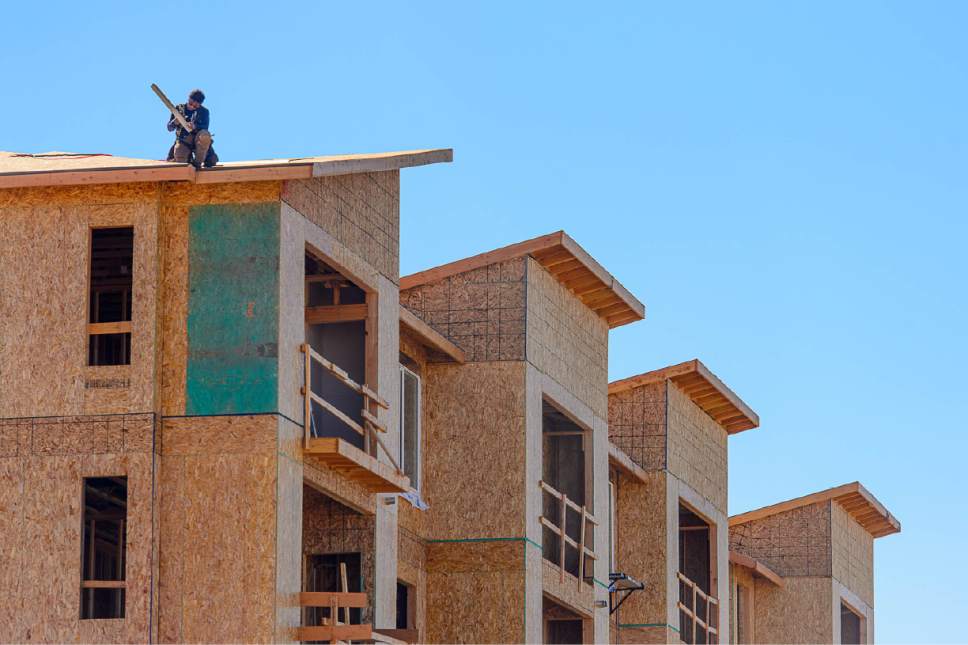This is an archived article that was published on sltrib.com in 2015, and information in the article may be outdated. It is provided only for personal research purposes and may not be reprinted.
The Wasatch Front apartment-building wave continues to make history while also contributing billions of dollars to the local economy, new numbers indicate.
One industry report says the region is gaining multifamily dwellings at a pace unseen for more than a generation. Separate research estimates the financial benefits from new apartment construction, property management and spending by incoming renters at about $2.7 billion for Salt Lake City just in 2013, cash that supported more than 24,800 jobs.
"It's definitely a boom time," said Paul Smith, executive director of the Utah Apartment Association.
Experts say a confluence of factors is behind the apartment trend in Utah, where traditionally about a third of residents rent their homes.
The state's healthy economy and steady population growth have combined with a national downturn in home ownership and shifts in preferences for mobility and urban living as a vast cohort of younger adults known as millennials form their own households. Up against rising prices on single-family houses, tighter lending rules and lagging incomes, many are opting to rent instead of buy, at least in the short term.
After a decade of adding an average of 1,223 new apartments annually, the greater Salt Lake City area could see up to eight times that many units come online in the next three years, according to EquiMark, which tracks the industry in Utah.
Nearly 4,839 apartments are under construction in Salt Lake County alone and work will start on an additional 6,484 units in the next 18 months. Together, those new dwellings amount to about 10 percent of Salt Lake County's existing inventory of 120,389 multifamily rental units.
Another 9,944 apartments are either planned or under construction across Davis, Utah and Weber counties, EquiMark said. Researchers documented 122 apartment projects being built or proposed across the four-county area, each with scores to hundreds of units apiece.
"We've never seen so much new construction in Salt Lake," said Sage Sawyer, a principal at EquiMark. The last boom even comparable was 30 years ago, he said, when apartment building accelerated as the U.S. came out of a global economic recession in the early 1980s.
In Salt Lake County, the new construction is focused in Salt Lake City's downtown, cities in the south end of the valley and along light-rail lines. Utah County's new projects, though centered on Provo and Orem, reach from American Fork to Payson.
In Weber County, apartments are mostly going up in Ogden and Pleasant View. Davis County has new projects in Layton, North Salt Lake, Centerville and Farmington.
Demand goes beyond millennials. At least eight new apartment complexes along the Wasatch Front will cater to seniors, with about 1,124 dwellings between them.
With the pace and breadth of new rental construction, EquiMark and others are warning that markets could be nearing a saturation point, where the number of new units starts to exceed would-be renters, creating downward pressure on rents. That said, even seasoned commercial analysts of Utah's apartment sector have seen recent predictions that the market would top out proved wrong.
"Some of these upscale, urban developments in Sugar House and downtown are getting two dollars per square foot in rent," said Pete Williams, a longtime expert in investment sales and development with Coldwell Banker Commercial. "I never thought I'd see that in my lifetime."
Whatever the long-term outlook, according to Smith with the Utah Apartment Association, right now "the demand is increasing faster than the supply."
Apartment vacancy rates — a closely watched metric for investors in apartment projects — remain low along the Wasatch Front. Fewer than five of every 100 apartments in Salt Lake County were empty and looking for a tenant last year— the lowest level since 2007. Average rents rose for a fifth straight year in 2014, to a 10-year high of $892 monthly by EquiMark's tally.
Rents have been on a similar trajectory in nearby counties, the group said, with average monthly payments reaching $868 in Utah County by the end of last year, compared with $796 in Davis County and $698 in Weber County.
All this activity is making a multibillion dollar impact to the state's economy, particularly for sectors hit hard by the Great Recession, according to a new study funded by two Washington, D.C.-area industry groups. Research commissioned by the National Multifamily Housing Council and the National Apartment Association pegs the 2013 impact from expanding apartment markets at $4.4 billion for Utah, with the largest share coming from spending by renters.
Those outlays contributed $1.9 billion to the city's economy, the study estimated. Apartment construction made a $347 million economic impact, while property management — the business of overseeing tenants, maintaining rentals and the like— chipped in $455 million. And that was part of a $1.3 trillion contribution by the apartment industry to the U.S. economy as a whole, the study said.
Stephen Fuller, an economist with George Mason University and one of the study's authors, called new apartment building across the U.S. "a significant and growing source of economic activity, jobs and personal earnings in communities nationwide."
Twitter: @Tony_Semerad







